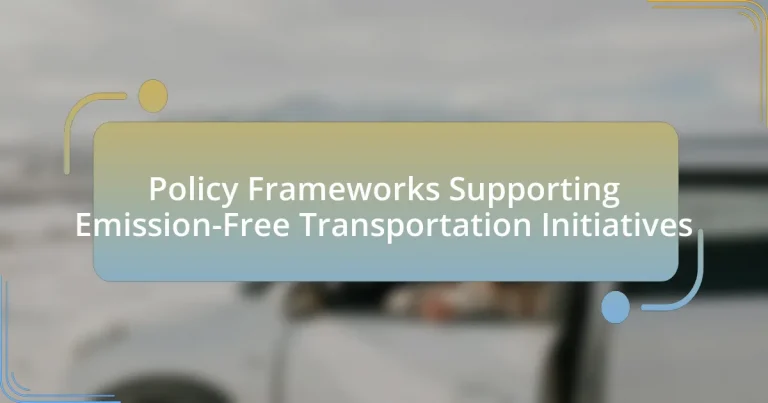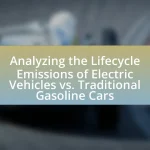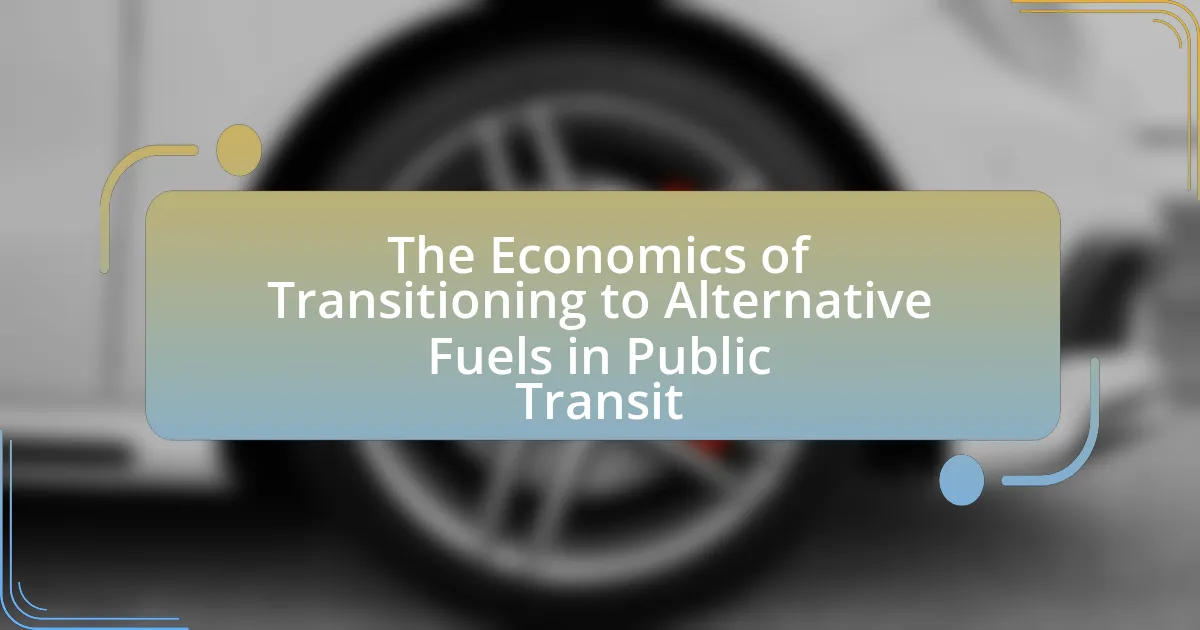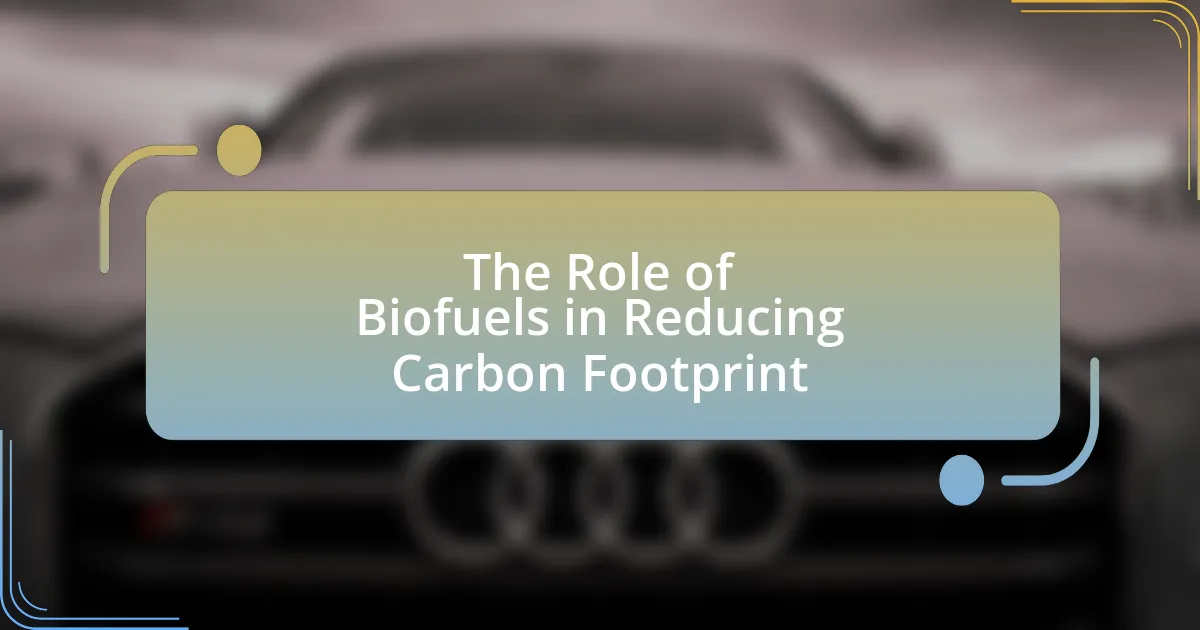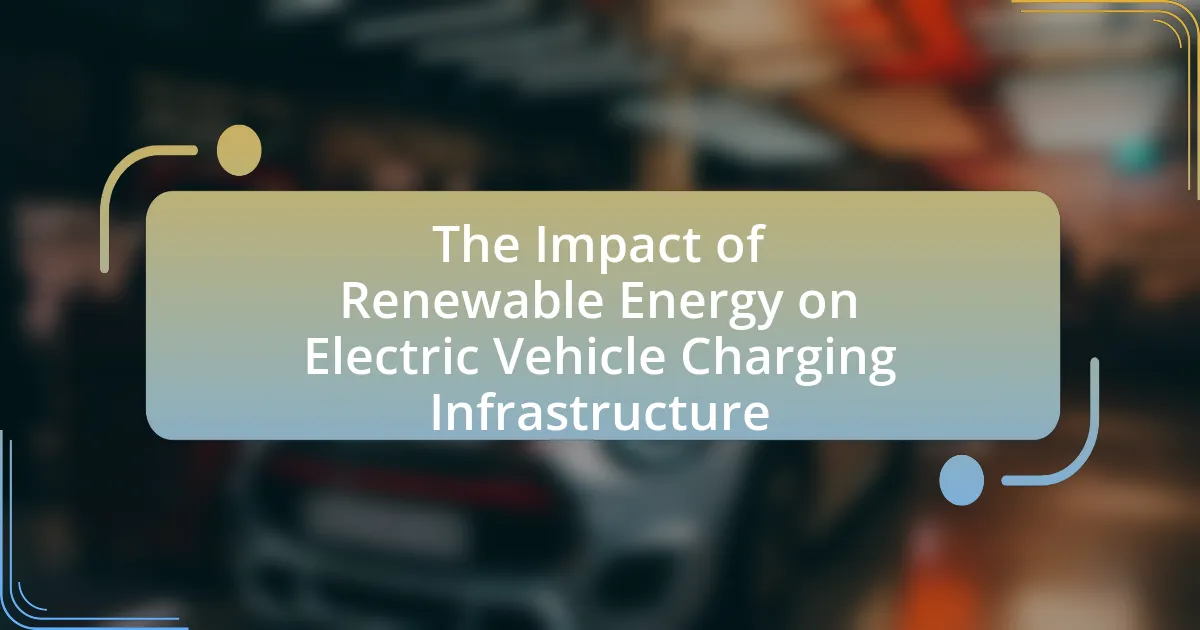The article focuses on policy frameworks that support emission-free transportation initiatives, detailing regulations, incentives, and strategic plans aimed at reducing greenhouse gas emissions in the transportation sector. It highlights key components such as regulatory measures, financial incentives, and infrastructure development, and discusses their influence on transportation systems and environmental sustainability. The article also examines the effectiveness of these frameworks, the challenges they address, and the collaborative efforts among stakeholders necessary for successful implementation. Additionally, it outlines best practices and lessons learned from successful initiatives, emphasizing the importance of data-driven decision-making and stakeholder engagement in shaping effective policies.
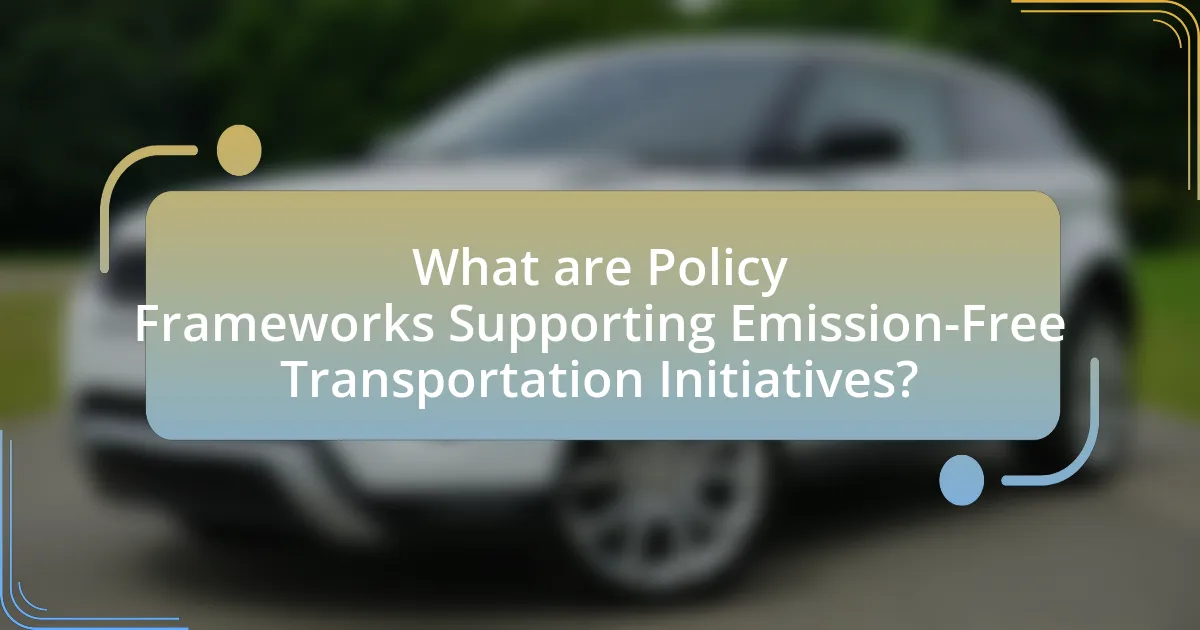
What are Policy Frameworks Supporting Emission-Free Transportation Initiatives?
Policy frameworks supporting emission-free transportation initiatives include regulations, incentives, and strategic plans aimed at reducing greenhouse gas emissions from the transportation sector. For instance, the European Union’s Green Deal aims to achieve net-zero emissions by 2050, promoting electric vehicles and sustainable public transport. Additionally, the U.S. federal government has implemented the Clean Air Act, which sets emissions standards for vehicles, and various states have adopted zero-emission vehicle mandates to encourage the adoption of electric cars. These frameworks are supported by funding programs, such as the Infrastructure Investment and Jobs Act, which allocates billions for electric vehicle charging infrastructure, thereby facilitating the transition to emission-free transportation.
How do these policy frameworks influence transportation systems?
Policy frameworks significantly influence transportation systems by establishing regulations, incentives, and standards that promote emission-free initiatives. These frameworks guide investments in sustainable infrastructure, such as electric vehicle charging stations and public transit enhancements, which are essential for reducing greenhouse gas emissions. For instance, the European Union’s Green Deal aims to cut emissions by at least 55% by 2030, driving member states to adopt cleaner transportation technologies and practices. Additionally, policies like California’s Zero Emission Vehicle Program mandate a certain percentage of new vehicle sales to be zero-emission, directly impacting manufacturers and consumers. Such frameworks create a structured environment that encourages innovation and shifts in consumer behavior towards more sustainable transportation options.
What key components are included in these policy frameworks?
Key components included in policy frameworks supporting emission-free transportation initiatives are regulatory measures, financial incentives, infrastructure development, and public engagement strategies. Regulatory measures establish standards for emissions and vehicle efficiency, while financial incentives, such as tax credits and subsidies, encourage the adoption of electric vehicles. Infrastructure development focuses on expanding charging networks and public transit systems to support emission-free options. Public engagement strategies aim to raise awareness and promote behavioral changes towards sustainable transportation choices. These components work together to create a comprehensive approach to reducing transportation emissions.
How do these components interact to promote emission-free transportation?
The components of policy frameworks, technological advancements, and infrastructure development interact synergistically to promote emission-free transportation. Policy frameworks establish regulations and incentives that encourage the adoption of electric vehicles and renewable energy sources, while technological advancements improve battery efficiency and reduce costs, making electric vehicles more accessible. Infrastructure development, such as charging stations and dedicated lanes for electric vehicles, supports the practical use of these technologies. For example, countries like Norway have implemented policies that provide tax exemptions and subsidies for electric vehicle purchases, resulting in over 54% of new car sales being electric in 2020. This interplay of supportive policies, innovative technologies, and robust infrastructure creates a conducive environment for the transition to emission-free transportation.
Why are policy frameworks essential for emission-free transportation?
Policy frameworks are essential for emission-free transportation because they establish the regulatory and financial structures necessary to promote sustainable practices. These frameworks provide clear guidelines and incentives for the development and adoption of clean technologies, such as electric vehicles and renewable energy sources. For instance, countries with robust policy frameworks, like Norway, have seen electric vehicle sales rise to over 54% of new car sales in 2020, driven by tax exemptions and subsidies. Such policies not only facilitate the transition to emission-free transportation but also ensure that stakeholders, including manufacturers and consumers, are aligned with environmental goals.
What challenges do these frameworks address in the transportation sector?
These frameworks address challenges such as reducing greenhouse gas emissions, improving air quality, and enhancing energy efficiency in the transportation sector. By implementing policies that promote electric vehicles, public transportation, and alternative fuels, these frameworks aim to mitigate the environmental impact of traditional transportation methods. For instance, the International Energy Agency reported that transportation accounts for approximately 24% of global CO2 emissions, highlighting the urgent need for effective policy interventions to transition towards emission-free solutions.
How do they contribute to environmental sustainability?
Policy frameworks supporting emission-free transportation initiatives contribute to environmental sustainability by promoting the adoption of clean energy technologies and reducing greenhouse gas emissions from the transportation sector. These frameworks often include regulations, incentives, and funding for electric vehicles, public transit systems, and infrastructure development, which collectively aim to decrease reliance on fossil fuels. For instance, the implementation of the Clean Air Act in the United States has led to significant reductions in air pollutants, demonstrating the effectiveness of regulatory measures in enhancing air quality and public health. Additionally, studies show that transitioning to electric vehicles can reduce carbon emissions by up to 70% compared to traditional gasoline vehicles, further underscoring the role of these policies in fostering a sustainable environment.
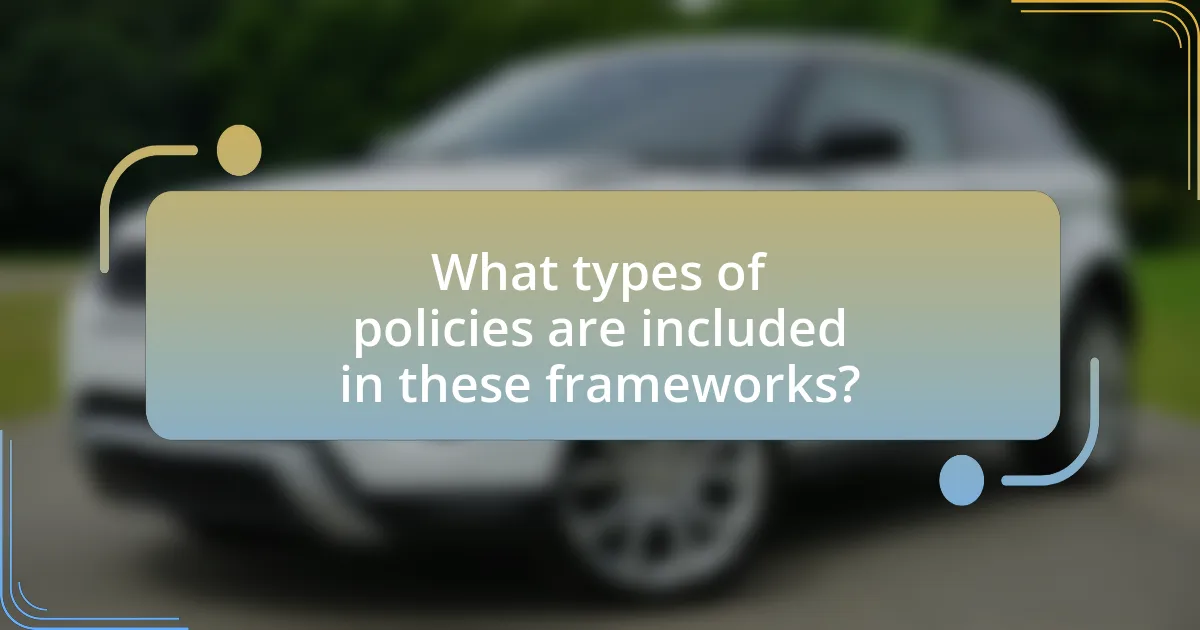
What types of policies are included in these frameworks?
The types of policies included in frameworks supporting emission-free transportation initiatives typically encompass regulatory measures, financial incentives, and infrastructure development strategies. Regulatory measures may include emissions standards and vehicle efficiency requirements aimed at reducing greenhouse gas emissions. Financial incentives often consist of subsidies for electric vehicle purchases, tax credits for renewable energy use, and grants for research and development in clean transportation technologies. Infrastructure development strategies focus on expanding charging networks for electric vehicles and investing in public transportation systems that prioritize low-emission options. These policies collectively aim to facilitate the transition to sustainable transportation solutions and have been implemented in various regions to promote environmental sustainability and reduce reliance on fossil fuels.
How do regulatory policies support emission-free transportation?
Regulatory policies support emission-free transportation by establishing standards and incentives that promote the adoption of clean technologies. For instance, government regulations often set stringent emissions targets for vehicles, compelling manufacturers to develop electric and hybrid models that produce zero or low emissions. Additionally, policies such as tax credits, subsidies, and grants for electric vehicle purchases encourage consumers to choose emission-free options. According to the International Council on Clean Transportation, countries with strong regulatory frameworks, like Norway, have seen electric vehicle market shares exceed 54% in new car sales as of 2021, demonstrating the effectiveness of these policies in driving the transition to emission-free transportation.
What specific regulations are most impactful?
The most impactful regulations supporting emission-free transportation initiatives include the Clean Air Act, which sets national air quality standards, and the Corporate Average Fuel Economy (CAFE) standards, which mandate fuel efficiency improvements for vehicles. The Clean Air Act has led to significant reductions in pollutants, contributing to improved public health and environmental quality. CAFE standards have driven innovation in vehicle technology, resulting in a 25% increase in fuel economy since their implementation. These regulations collectively promote the transition to cleaner transportation options and reduce greenhouse gas emissions.
How do these regulations vary across different regions?
Regulations supporting emission-free transportation initiatives vary significantly across different regions due to local environmental policies, economic conditions, and technological capabilities. For instance, the European Union has stringent emissions targets and mandates for electric vehicle adoption, while the United States has a more fragmented approach, with states like California implementing aggressive regulations compared to others. In Asia, countries like China have invested heavily in electric vehicle infrastructure and incentives, leading to rapid adoption, whereas other regions may lack such comprehensive frameworks. These differences are influenced by factors such as government priorities, public transportation infrastructure, and the availability of renewable energy sources, which shape the effectiveness and implementation of emission-free transportation policies.
What role do financial incentives play in these policy frameworks?
Financial incentives are crucial in policy frameworks supporting emission-free transportation initiatives as they encourage the adoption of cleaner technologies and practices. These incentives, such as tax credits, rebates, and grants, lower the financial barriers for consumers and businesses, making electric vehicles and renewable energy sources more accessible. For instance, the U.S. federal tax credit for electric vehicles can reduce the purchase price by up to $7,500, significantly influencing consumer decisions. Additionally, studies show that regions with robust financial incentives experience higher rates of electric vehicle adoption, demonstrating their effectiveness in promoting sustainable transportation solutions.
What types of financial incentives are commonly offered?
Commonly offered financial incentives include tax credits, rebates, grants, and low-interest loans aimed at promoting emission-free transportation initiatives. Tax credits reduce the amount of tax owed, making electric vehicles more affordable; for instance, the U.S. federal tax credit for electric vehicles can be up to $7,500. Rebates provide immediate cash back to consumers upon purchase, such as state-level rebates that can range from $1,000 to $5,000. Grants are often provided to organizations or municipalities for infrastructure development, like charging stations, with funding from government programs. Low-interest loans facilitate the purchase of electric vehicles or the development of sustainable transport projects, often backed by government agencies to encourage adoption. These incentives are designed to lower the financial barriers associated with transitioning to emission-free transportation.
How effective are these incentives in promoting emission-free initiatives?
Incentives are highly effective in promoting emission-free initiatives, as evidenced by their ability to significantly increase the adoption of electric vehicles (EVs) and renewable energy sources. For instance, countries that implemented tax credits and rebates for EV purchases, such as Norway, saw EV market shares rise to over 54% in 2020, demonstrating a direct correlation between financial incentives and consumer behavior. Additionally, research from the International Council on Clean Transportation indicates that incentives can reduce the total cost of ownership for EVs, making them more appealing to consumers and accelerating the transition to emission-free transportation.
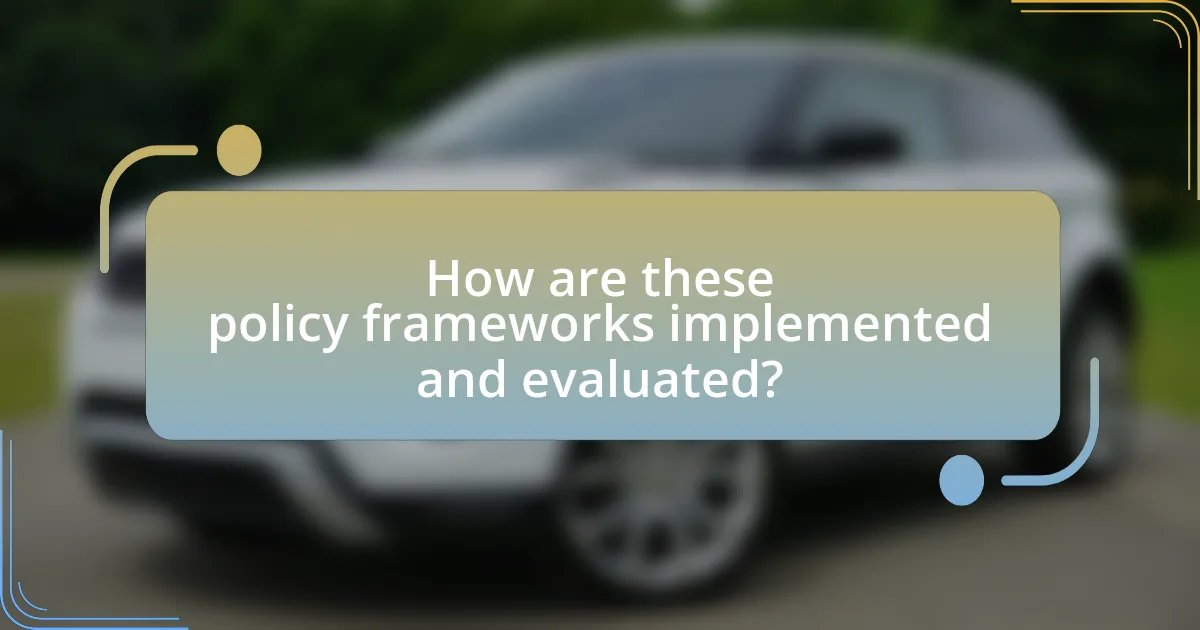
How are these policy frameworks implemented and evaluated?
Policy frameworks supporting emission-free transportation initiatives are implemented through a combination of regulatory measures, funding allocations, and stakeholder engagement. These frameworks are evaluated using performance metrics such as emission reductions, adoption rates of clean technologies, and cost-effectiveness analyses. For instance, the European Union’s Clean Mobility Package includes specific targets for reducing greenhouse gas emissions from transport, which are monitored through annual reports and assessments. Additionally, pilot programs and case studies provide empirical data on the effectiveness of various initiatives, allowing policymakers to adjust strategies based on real-world outcomes.
What strategies are used for the implementation of these frameworks?
Strategies for the implementation of policy frameworks supporting emission-free transportation initiatives include regulatory measures, financial incentives, and public-private partnerships. Regulatory measures involve establishing emissions standards and mandates for electric vehicle adoption, which have been shown to drive market transformation, as evidenced by California’s Zero Emission Vehicle Program. Financial incentives, such as tax credits and subsidies for electric vehicle purchases, encourage consumer adoption and have been effective in increasing sales, with studies indicating that such incentives can boost electric vehicle market share significantly. Public-private partnerships facilitate collaboration between government entities and private companies, enabling the development of charging infrastructure and innovative technologies, which are crucial for supporting the transition to emission-free transportation.
How do stakeholders collaborate in the implementation process?
Stakeholders collaborate in the implementation process by engaging in coordinated efforts that involve communication, resource sharing, and joint decision-making. This collaboration typically includes government agencies, private sector companies, non-profit organizations, and community groups working together to align their objectives and strategies. For instance, in emission-free transportation initiatives, stakeholders may form partnerships to develop infrastructure, share technological advancements, and create policies that support sustainable practices. Evidence of effective collaboration can be seen in projects like California’s Zero Emission Vehicle Program, where multiple stakeholders, including automakers and state agencies, have successfully worked together to increase the adoption of electric vehicles through shared goals and resources.
What are the common barriers to effective implementation?
Common barriers to effective implementation of emission-free transportation initiatives include inadequate funding, lack of stakeholder engagement, insufficient infrastructure, and regulatory challenges. Inadequate funding limits the resources available for projects, making it difficult to develop and maintain necessary systems. Lack of stakeholder engagement can lead to resistance from communities and businesses, hindering collaboration and support. Insufficient infrastructure, such as charging stations for electric vehicles, restricts the adoption of new technologies. Regulatory challenges, including complex permitting processes and outdated policies, can delay or obstruct implementation efforts. These barriers collectively impede progress toward achieving emission-free transportation goals.
How is the success of these policy frameworks measured?
The success of policy frameworks supporting emission-free transportation initiatives is measured through key performance indicators (KPIs) such as reductions in greenhouse gas emissions, increases in the adoption of electric vehicles, and improvements in public transportation usage. These metrics provide quantifiable data that reflect the effectiveness of the policies implemented. For instance, a study by the International Council on Clean Transportation found that regions with robust emission-free policies saw a 30% increase in electric vehicle registrations within two years, demonstrating a direct correlation between policy frameworks and adoption rates. Additionally, tracking air quality improvements and public health outcomes can further validate the success of these initiatives.
What metrics are used to evaluate their effectiveness?
Metrics used to evaluate the effectiveness of policy frameworks supporting emission-free transportation initiatives include greenhouse gas emissions reductions, adoption rates of electric vehicles, and improvements in air quality. Greenhouse gas emissions reductions are quantified by measuring the decrease in CO2 and other harmful emissions resulting from the implementation of these policies. Adoption rates of electric vehicles are tracked through sales data and market penetration statistics, indicating how well the policies encourage consumers to switch to cleaner transportation options. Improvements in air quality are assessed through monitoring changes in pollutant levels, such as nitrogen oxides and particulate matter, in urban areas where these initiatives are implemented. These metrics provide concrete evidence of the policies’ impact on achieving emission-free transportation goals.
How do these evaluations inform future policy adjustments?
Evaluations inform future policy adjustments by providing data-driven insights into the effectiveness of current transportation initiatives. These assessments analyze key performance indicators such as emissions reductions, cost-effectiveness, and public adoption rates, enabling policymakers to identify successful strategies and areas needing improvement. For instance, a study by the International Council on Clean Transportation found that cities implementing electric vehicle incentives saw a 30% increase in adoption rates, prompting similar policies in other regions. This evidence-based approach ensures that future policies are tailored to maximize impact and efficiency in achieving emission-free transportation goals.
What best practices can be adopted for effective policy frameworks?
Effective policy frameworks for emission-free transportation initiatives should prioritize stakeholder engagement, data-driven decision-making, and clear regulatory guidelines. Stakeholder engagement ensures that diverse perspectives are considered, fostering collaboration among government, industry, and community members. Data-driven decision-making relies on accurate data collection and analysis to inform policies, leading to more effective outcomes. Clear regulatory guidelines provide a structured approach for implementation, ensuring compliance and accountability. For instance, the International Energy Agency emphasizes the importance of comprehensive policy packages that include incentives for electric vehicle adoption and infrastructure development, which have proven successful in various countries.
How can policymakers engage stakeholders in the process?
Policymakers can engage stakeholders in the process by implementing inclusive consultation mechanisms that facilitate dialogue and feedback. This approach ensures that diverse perspectives, including those from community members, industry representatives, and environmental organizations, are considered in decision-making. For instance, the California Air Resources Board has successfully utilized public workshops and stakeholder meetings to gather input on emission reduction strategies, demonstrating the effectiveness of direct engagement in shaping policies that reflect community needs and priorities.
What lessons have been learned from successful initiatives?
Successful initiatives in emission-free transportation have demonstrated the importance of comprehensive policy frameworks that integrate stakeholder engagement, technological innovation, and financial incentives. These frameworks have shown that collaboration among government, industry, and communities is essential for achieving sustainable outcomes. For instance, the implementation of California’s Zero Emission Vehicle program has led to a significant increase in electric vehicle adoption, illustrating the effectiveness of regulatory support combined with consumer incentives. Additionally, successful initiatives highlight the necessity of continuous evaluation and adaptation of policies to respond to emerging challenges and opportunities in the transportation sector.
